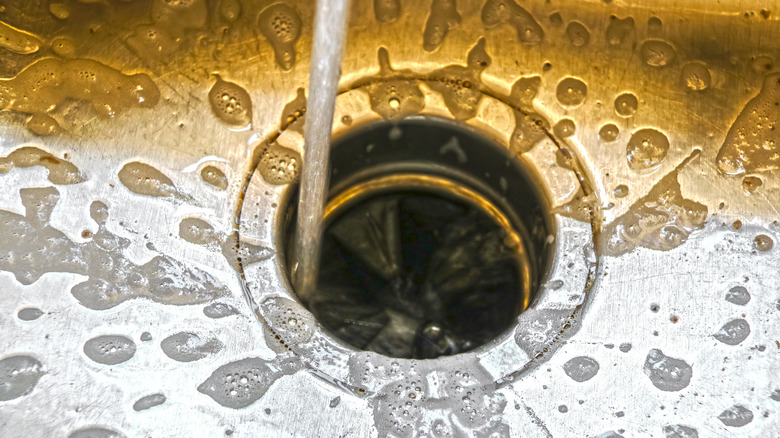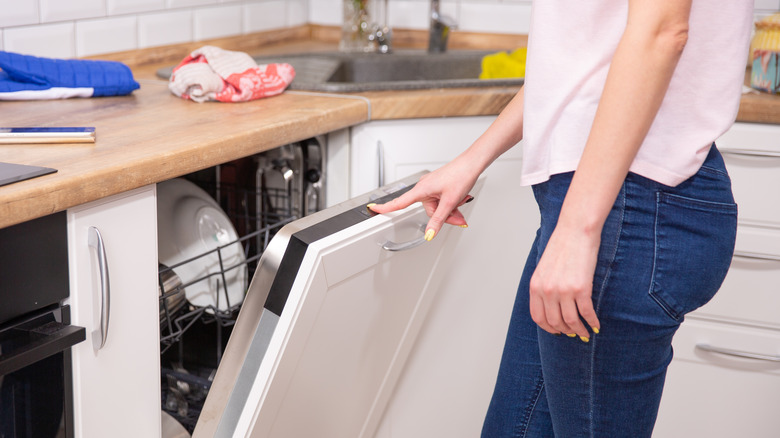How To Fix A Dishwasher That Isn't Draining
A broken dishwasher is undoubtedly an inconvenience. Over time, there are numerous things that can go wrong with it. Generally, dishwashers last approximately seven to ten years, but sometimes 12 or more. This greatly depends upon the brand, care, maintenance, and how often it is used.
On average, a new dishwasher costs between $500 and $1,000. To that end, if the water in your dishwasher isn't draining, do you replace it or fix it? According to HomeServe, you shouldn't pay more to fix it than to replace it (no more than 50% of its original cost). Also, if you've had to repair your dishwasher several times within the year, that's a definite indicator it's certainly time to replace it.
When it comes to a swamped dishwasher, there are several ways to approach fixing this common problem before going the new purchase route. Depending on the model of your dishwasher, troubleshooting will ultimately determine what the issue is. Start with the more obvious concerns, then dive deeper from there.
Turn off the power to your dishwasher
In your initial effort towards this home endeavor, its vital to turn off the power to your dishwasher to protect yourself by chance from being shocked or electrocuted, per The Spruce. Locate the power supply and unplug it right away (usually a white or yellow cord) or switch it off via the circuit breaker before starting. If the plug is not located under the sink, then it's probably wired. You never want to run the risk of injuring yourself by getting zapped, so take the time for these precautions.
Remove debris from the filter
Start by drying out the water that is pooled in the bottom of your dishwasher to better access the filter (most modern machines have a filter you can access). You can use a towel, rag, or wet vacuum. Next, remove any visible debris from the bottom of your dishwasher. Per Home Depot, look at your dishwasher's side sticker to establish the model and the proper way to remove the filter. Once removed, simply wash the parts of your filter with hot water and soap, scrub with a toothbrush, and then place them back inside when finished.
Clean your dishwasher
Next, clean your dishwasher. Empty out all the contents of your dishwasher and run a cycle with a cup of vinegar placed on the top rack. For a more in-depth, abrasive clean, run a wash with a cup of baking soda to flush out extra build up as well. If your dishwasher is still not draining correctly, Home Depot recommends pouring equal parts of vinegar and baking soda down through the basket of your dishwasher. Let this work for 15 minutes. Then pour in hot water and put it on rinse. This will give your dishwasher a fortified clean.
Check the dishwasher pump for any clogs
If your dishwasher still won't drain, check the pump for any major jams. A big object could be keeping your drainage system from working properly. Common things found are large fragments of food, paper, or even broken pieces of glass. The pump is generally located underneath the drain; you'll need to remove the pump cover to retrieve it. Explore this area further by using a wire hanger for hard to get to objects that might be stuck down there, suggests House Method.
Clean the pump
Cleaning out your dishwasher's pump and its parts will give its internal life a thorough detox, as noted by Hunker. Dishwasher pumps have two impellers: one that sprays the water into it and one that pumps it out to the drain. Remove any visible pieces that may be creating a blockage. It's good to wear gloves during this process to protect your hands from any debris or sharp, broken pieces. Again, clean it by rinsing it thoroughly with water and a sponge or any other brush like tool you prefer.
Clear the sump pump
Additionally, check the condition of your dishwasher's sump pump if your dishwasher isn't draining. This device assists in collecting and controlling the water flow into the drain pump of the dishwasher. Notice any cracks or broken parts here as well, as this may be the cause of any pressing matters. If water is present around your dishwasher or the sump shows apparent damage, replace it as soon as possible. HomeSteady suggests keeping an eye on your sump pump periodically so it remains debris free. This helps reduces any chances of water overflow.
Investigate the drain hose
A glitch in the drain hose is another possibility your dishwasher won't drain. Often located under sink between the pump and drain line, the hose may get twisted or bent out of shape with use. Make sure the hose is securely fastened and straighten out any kinks (these tend to occur with older hoses). To loosen any obstructions, House Method also notes to simply blow air through it at one end. The hose is usually held with barbed fitting. To remove it, loosen the clamps that hold it in place.
Run the garbage disposal
Since your dishwasher and sink drain are interconnected, make sure to run the garbage disposal until it's clean and clear. If your disposal happens to be blocked, then that's a definite answer to why your dishwasher isn't draining properly. Run the sink's disposal with water, as this process will help flush out the remaining particles better. Also, the air gap is a little device that prevents any possible contaminated water from draining back into your dishwasher. If it's blocked, this will cause a draining problem as well. Check and remove any blockages by removing the drain hose where it connects to the garbage disposal.
Clean the spray arms
Cleaning the spray arms is another step in the right direction to figuring out why your dishwasher won't drain. Spray arms may get clogged with various food debris or other items, but according to Puls, it's more often because of hard water. Remove and clean your dishwasher's spray arms by soaking them in vinegar. This will loosen up the overall residue. Also, unclog the spray holes of any buildup by using a wire hanger or any other suitable tool you have.
Load the dishwasher properly
Load your dishwasher accurately every time. Again, check your owner's manual for its proper function (check online if you don't have it). Arrange your dishes and utensils in a way that is appropriate for your dishwasher model. Don't load items that should be hand-washed, such as wooden utensils, plastic bowls, and cups; these can melt and produce more debris during the washing process. Always place items at a good distance from each other for optimum cleaning. American Home Shield suggests never to overload your dishwasher; this will either keep your dishes from a full cleaning or cause buildup within your draining system.
Make sure the latch is secure
If you haven't already noticed this, make sure your dishwasher's latch is absolutely closed. If the latch is unlocked, it will not be able to ultimately drain the cycle's water. You should hear a click sound when it's locked. If not, you may need a new latch. According to Remove and Replace, check to make sure the latch is in alignment with the strike plate. If not, you may need to replace these parts if either are cracked or damaged.
Check the drain valve
Not all dishwashers have drain valves, but if they do, a further jam inspection would include checking this part. For dishwashers with drain valves, either a single direction or reversing motor will exist. Single direction motors possess two to three wires, while reversing motors have four. If you've established the drain valve in yours, press on the bracket to make sure it moves efficiently. This regulator consists of solenoid, a vital component in the process of the drain valve to work electromagnetically, thus also contributing to its draining function, per SF Gate.
Test the motor
The best way to find a solution to something is to test it. It's obvious — if the drain pump motor to your dishwasher isn't working, then the machine won't drain. If you're uncertain of the power that your motor is projecting, physically test the motor with an accurate multimeter reading, suggests Spareka. Although, if it's receiving power but still doesn't function correctly, then it's time to replace it. Also, listen for abnormal noises (hums without turns), or not even starting at all.
Call a professional
Dishwashers are complex and debris can often find itself in lots of fickle places within this cleaning machine. If you've tried all these methods and you're still looking for better results, then don't hesitate to reach out to a professional. Call on a plumber or appliance repair technician, as noted by Bob Vila. To confirm your dishwasher's status, run a complete empty cycle again and see if any remaining water stands at the bottom before you decide on the next direction.














